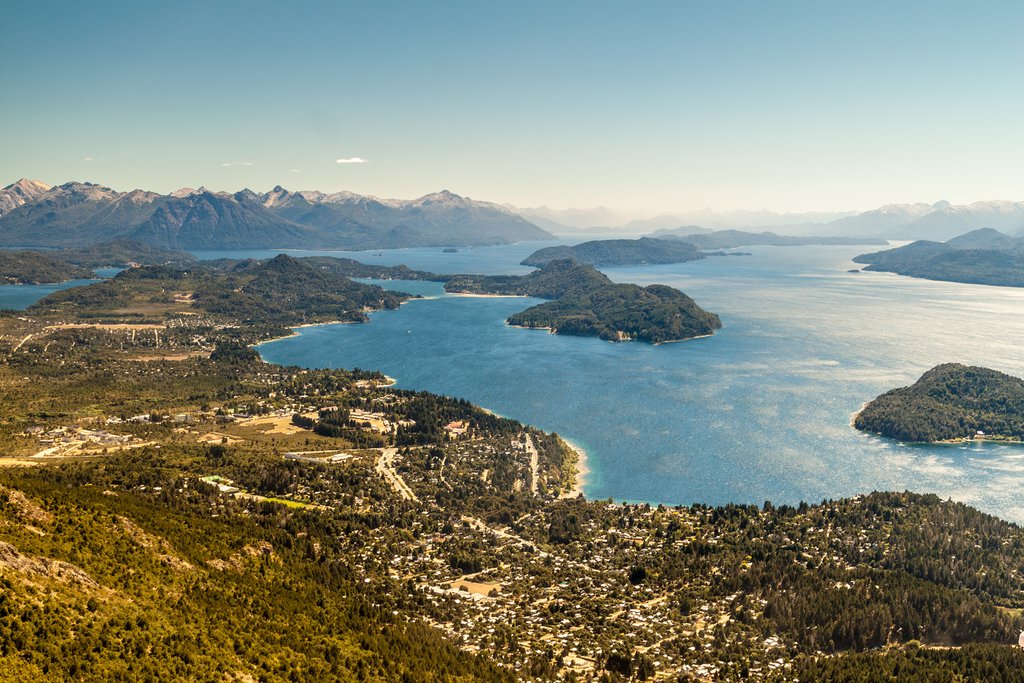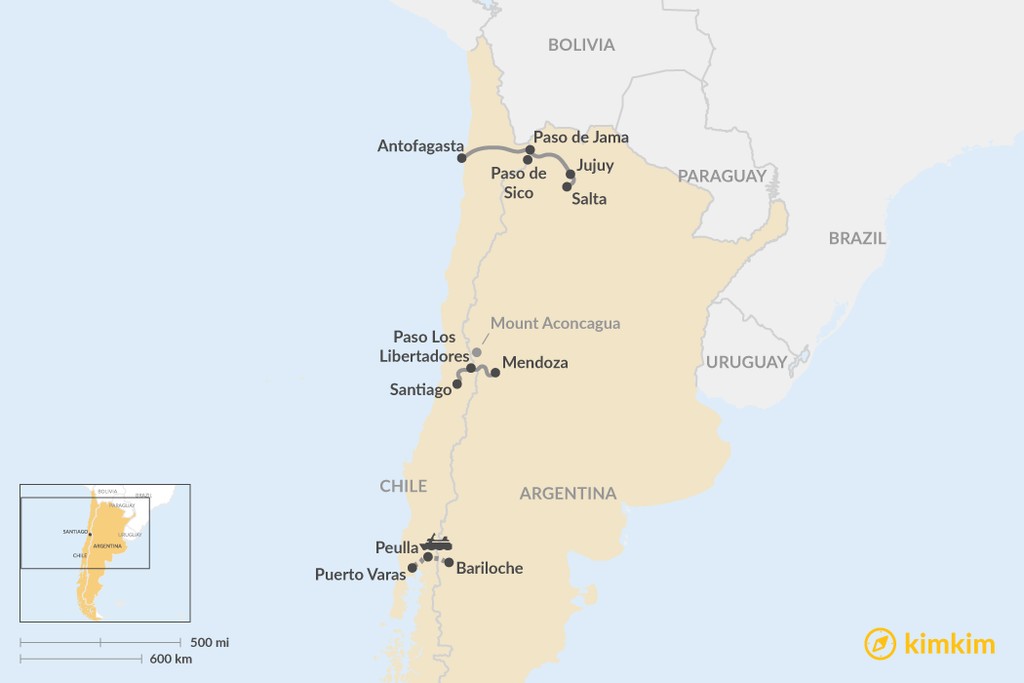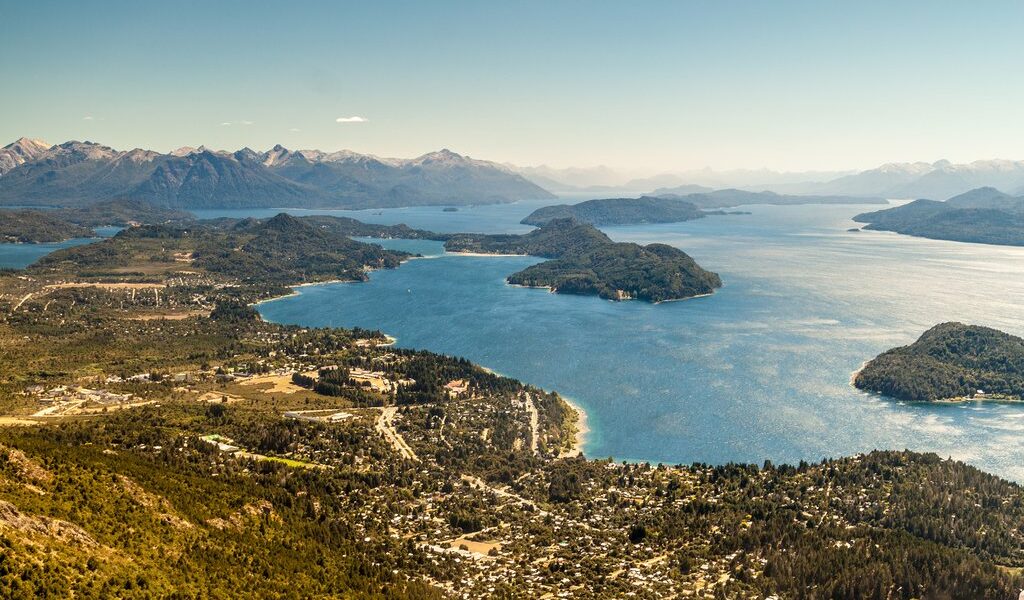
Crossing the border between Argentina and Chile is a memorable journey in itself. There are three main crossing points, each with distinct scenery—and modes of transportation. After sipping wine in Mendoza, bus over the snow-capped Andes to Santiago. Cruise in a catamaran across glacial lakes from Bariloche. Or, cross the dramatic Atacama Desert, passing through a center of Argentine indigenous culture. Learn more about all three options below.
## Exploring Border Crossing Options Between Argentina and Chile by Boat and Bus
Stretching an impressive 3,300 miles, the border that separates Argentina and Chile ranks as the third-longest international border in the entire world. This vast expanse offers numerous points where travelers can make a crossing, and a multitude of methods to do so. While driving and even horseback riding are possibilities, the majority of visitors opt for the convenience and accessibility of boats or buses. The specific border crossing you ultimately select will depend on a variety of factors, including the destinations featured in your broader travel itinerary, the budget you have allocated for transportation, your personal tolerance for high altitudes, and, perhaps most importantly, the amount of time you are willing to dedicate to the journey.
It’s important to note that the itineraries detailed below are primarily described from the perspective of traveling from Argentina to Chile. However, it is equally common and popular to make the journey in the opposite direction, from Chile to Argentina. In this case, the itineraries and the experiences are largely similar, simply reversed.
| Route | Travel time | Pros | Cons | Best for |
| Mendoza to Santiago | 7-8 hours | Offers breathtaking scenic views, remains relatively affordable compared to other options, and is a relatively quick way to traverse the border. You’ll also get to see the majestic views of the highest mountain in the Americas, Mount Aconcagua. | Weather conditions can sometimes have a significant impact on bus schedules, potentially causing delays or cancellations. Furthermore, the winding roads may present a challenge for individuals prone to carsickness. | Ideal for wine enthusiasts who are eager to explore the renowned vineyards of the Mendoza region, as well as travelers who are particularly interested in immersing themselves in the stunning mountain scenery of the Andes. |
| Bariloche to Puerto Varas | 9-13 hours | Provides captivating views of volcanoes, glaciers, and lush rainforests, all visible from the comfort of the boat. There are also opportunities for optional stops at key natural attractions along the way, allowing for a more immersive experience. | This route tends to be more costly than other border crossing options. It also requires booking well ahead of time due to its popularity. It’s also important to note that not all required fees are included in the initial ticket price, so additional expenses should be anticipated. | Perfect for travelers who are particularly interested in experiencing boat travel and enjoying the unique perspective it offers. It is also well-suited for those who have extra time to spare and a flexible budget, allowing them to fully appreciate the journey. Finally, it’s a great choice for individuals who are prone to altitude sickness, as this route involves lower elevations. |
| Salta to San Pedro de Atacama | 11 hours | Tickets are generally easy to obtain, even at the last minute. The route is also relatively affordable, making it a budget-friendly option. And, of course, it offers stunning views of the unique desert scenery. | Weather conditions can occasionally disrupt schedules. The passage is also less developed for tourism compared to the other routes, meaning fewer amenities and services are available. Finally, there are typically fewer departures each day or week, requiring more careful planning. | An excellent choice for desert adventurers who are eager to explore the arid landscapes of the Atacama. It’s also a good option for budget-conscious travelers who are looking for a more economical way to cross the border. Lastly, it caters to travelers who are interested in immersing themselves in the rich indigenous cultures of the region. |
## Crossing the Mighty Andes Between Mendoza and Santiago
This highly sought-after border crossing offers a wealth of attractions, including breathtaking mountain scenery that famously served as a stand-in for the Himalayas in the 1997 film, *Seven Years in Tibet*. Beyond the mountains, the landscape is dotted with sprawling vineyards on both sides of the border, stretching out in seemingly endless rows. The bus journey takes travelers high into the majestic Andes Mountains via the Paso Los Libertadores, reaching elevations of over 10,000 feet. Along the way, passengers will be treated to views of sparkling mountain streams, an abundance of cacti, and magnificent snow-capped peaks, including the iconic Mount Aconcagua, which, at 22,837 feet, is the highest mountain in all of the Americas. Other notable highlights that you might catch a glimpse of from the bus window include Puenta del Inca, a remarkable natural rock bridge that was once used by the Incas.
While the ride itself typically takes around six hours, it’s important to factor in the time required to clear customs and immigration. With these additional steps, you should anticipate spending at least seven to eight hours to complete the trip. Departing from Mendoza, the first few hours of the journey involve a gradual ascent in elevation. After successfully navigating customs and immigration at the high-altitude border crossing, the bus will begin its descent towards Santiago. Be aware that the numerous hairpin turns in the road, while enjoyable for some passengers, may pose a challenge for those who are prone to motion sickness.
**Start and end points:** Mendoza, Argentina and Santiago, Chile
**Travel Time:** 7-8 hours
**Key features:** The journey offers unparalleled mountain scenery, including stunning views of Mount Aconcagua, the highest mountain in the Americas. Furthermore, the start or end points are located in Mendoza, South America’s most famous wine-growing region, and Santiago, Chile’s vibrant and cosmopolitan capital city.
**Practical Considerations:** Booking your tickets well in advance is highly recommended, as this is a popular route and buses tend to fill up quickly, particularly during the peak travel season. It’s worth noting that while many bus companies offer the convenience of online ticket purchases, some only release tickets for sale approximately one month prior to the intended date of travel. Most companies provide more than one class of service, so you can select the option that best suits your needs and budget. If you are planning to travel overnight, which may diminish the experience of enjoying the mountain scenery, be sure to book a cama (bed) seat for added comfort.
## The Enchanting Lake Crossing from Bariloche to Puerto Varas
The Andean lake journey transcends a mere border crossing, evolving into an unforgettable travel experience in its own right. This unique journey seamlessly combines two forms of transportation – boat and bus – to transport travelers across three stunning lakes, past breathtaking national parks, imposing volcanoes, majestic mountains, and cascading waterfalls. While tickets for the lake crossing are generally more expensive compared to other border crossing options, and seats tend to sell out well in advance, many travelers consider it to be among their most cherished South American adventures.
Departing from the picturesque town of Bariloche, the journey begins with a bus ride to Puerto Pañuelo, where you’ll board a catamaran for a scenic hour-long cruise across the pristine waters of Nahuel Huapi Lake. Upon reaching the other side, at Puerto Blest, you’ll have the opportunity to observe a variety of exotic bird species before embarking on a short bus ride to another nearby port. From Puerto Alegre, you’ll board a second boat for a tranquil journey across Lake Frías. From this point forward, you’ll be treated to awe-inspiring views of towering mountains, majestic volcanoes, and shimmering glaciers that line the landscape.
Travelers will pass through Argentine customs and Chilean immigration in the towns of Puerto Frías (by boat) and Peulla (by connecting bus), respectively. The route then enters Vicente Pérez Rosales National Park, renowned as Chile’s first national park. Here you can take a lunch break. The next segment of the journey involves another boat ride, this time crossing the breathtaking Todos los Santos Lake while soaking in the magnificent views of the Osorno and El Tronador volcanoes. Finally, you’ll board a bus for the final leg of the journey to Puerto Varas, with the option of stopping at the captivating Petrohué Waterfalls along the way.
This itinerary describes the one-day, one-way lake crossing. If you have extra time and resources, consider the two-day trip, which includes an overnight stay in the charming Chilean town of Peulla. You can also experience the same route in reverse, traveling from Chile to Argentina.
**Start and end points:** Bariloche, Argentina and Puerto Varas, Chile
**Travel Time:** 9-13 hours (for the one-day crossing)
**Key features:** This journey involves a significant amount of time on the water, as the boat crosses three distinct lakes. The route also encompasses a diverse range of landscapes, from snow-capped volcanoes to lush rainforests. There are also opportunities for short hikes and visits to a variety of natural attractions.
**Practical Considerations:** This option is particularly well-suited for travelers who are sensitive to altitude sickness, as there is no significant change in elevation throughout the journey. However, the lake crossing typically requires more time and money compared to other border crossing options between Chile and Argentina. It’s also important to note that many costs, including national park entrance fees and meals, are not included in the ticket price and must be paid separately. Booking your tickets well in advance is highly recommended, especially during peak travel seasons.
## The Northernmost Desert Pass Between Salta and the Atacama
Comparable to the Mendoza to Santiago crossing in terms of scenic beauty is the journey between Salta, Argentina and San Pedro de Atacama, Chile. This is another high-altitude border crossing that offers stunning desert scenery along the way. Paso de Jama is the name of the mountain pass that connects the two countries at this point, a road that ascends to almost 14,000 feet. (Note that there is another option in the region, Paso de Sico, leading between Salta and Antofagasta, Chile. But because Antofagasta does not offer as many attractions for international travelers as San Pedro de Atacama, the Salta-San Pedro de Atacama trip is generally preferable.)
Leaving from Salta, you’ll enjoy desert landscapes from the bus window on the route to Jujuy, one of Argentina’s most important centers of indigenous culture. (You can also board the bus here, if you happen to be in Jujuy.) The bus climbs higher and higher in elevation as you pass colorful rock formations, fields of cacti, and llamas and alpacas grazing by the roadside. The journey passes through several small towns without stopping before reaching border control. From there, it’s a two-hour downhill ride to San Pedro de Atacama.
**Start and end points:** Salta, Argentina and San Pedro de Atacama, Chile
**Travel Time:** 11 hours
**Key features:** The journey features colorful rock formations, dramatic desert landscapes, and the chance to spot llamas and alpacas. The route starts and ends in popular destinations, Salta and San Pedro.
**Practical Considerations:** Bus companies only make this trip a few times a week: check schedules carefully and plan ahead. As with any passage over the Andes, weather can impact travel.
Bring your own food and drinks. Bus companies usually serve some kind of a meal or snack, but it’s not much considering the length of this trip, and there aren’t any places to buy things along the way.
Leaving from Salta, try to get a bus seat on the left side of the bus for the best views (sit on the right side if you’re traveling the other direction, from Chile to Argentina.)
## Which Border Crossing is the Right Choice for You?
The lake crossing is considered a top South American experience for many travelers, and is a journey you’ll likely remember for years to come. But the overland journeys from Mendoza to Santiago or from Salta to San Pedro de Atacama also offer stunning views from the bus. Choose the option that’s most convenient for your itinerary—you’re sure to have a memorable experience no matter what.

B-73

